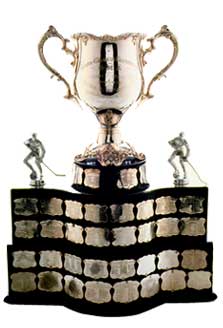Book Review: Hitman by Bret Hart
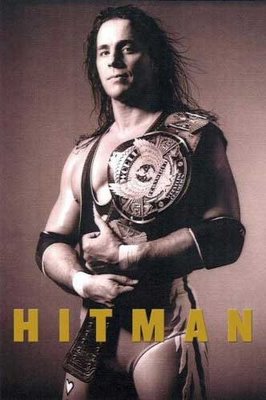 I received Bret “the Hitman” Hart’s autobiography as a Christmas present two years ago, and put it on my ever-growing reading list. Well, its turn finally came around and I’m glad it did – it’s a fascinating, although somewhat disturbing, read.
I received Bret “the Hitman” Hart’s autobiography as a Christmas present two years ago, and put it on my ever-growing reading list. Well, its turn finally came around and I’m glad it did – it’s a fascinating, although somewhat disturbing, read.
Hart has had one of the most successful careers in professional wrestling history, starting in Calgary with his father’s Stampede Wrestling and rising through the ranks of the business to win the top titles in both the World Wrestling Federation and the rival World Championship Wrestling.
His memoir is very family-centric, looking at his relationship with his parents Helen and Stu, his 11 siblings, their spouses and his wife Julie. He also discusses in great detail the end of his tenure in the WWF, when promoter Vince McMahon and some of Hart’s co-workers conspired to strip Hart of the World Championship belt before leaving for WCW.
One of the last of the truly old school wrestlers, Hart always maintained the professional wrestling code of honour –kayfabe – that the fact that the matches are pre-determined never be revealed. When he was an active wrestler, he and his brother Owen did not speak to each other in public for years because in the storylines they were enemies.
However, the Harts broke kayfabe for the filming of the documentary Wrestling with Shadows, which coincidentally covered the abrupt end of his career with the WWF.
This event, known to wrestling fans as “the Montreal Screwjob” is the climax of the book’s third act, bringing to a head simmering professional and sibling rivalries that sink Hart into a deep depression. Ultimately, it leads to a life-changing stroke that paralyzes the athletically gifted Calgarian.
Hart’s writing is striking not just because of the content, but also the tone. His family settles most of its squabbles through violence. His fellow wrestlers indulge in performance enhancing and recreational drugs at an alarming rate. Hart writes candidly about his many extra-marital affairs that wreck havoc on his already tempestuous marriage. Somehow, Hart has a nonchalant tone about the dysfunction that surrounds him throughout the book.
Even then, Bret seems dowdy compared to some of his brothers like Smith, who has fathered countless children out of wedlock, or Dean, whose drug use exacerbates his Bright’s Disease, eventually leading to kidney failure.
The tragic death of Owen, the youngest member of the Hart clan, is the final straw as the family implodes. The family becomes divided as various siblings turn on each other, trying to publicly embarrass their rivals or force them into bankruptcy.
As the Hart’s are at war, Bret’s wrestling family also turns on him. In particular, Vince McMahon, Shawn Michaels and Hunter Hearst Helmsley align against him to oust him from his position as the face of the WWF.
It’s an emotional, dark read that will shock the reader with its graphic descriptions of Hart’s lonely, violent and nomadic life as a professional wrestler.
I’d recommend Bret Hart’s memoir to anyone, professional wrestling fan or not, for its candid look at what amounts to office politics as well as the tragic undoing of the Hart family. There are lessons to be learned from Hart’s life that go beyond how to take a chair to the head or how to make yourself bleed.
The Arenas Rule

With an unseemly Arenas Rule Point rating of 8, no NBA executive should consider Stephon Marbury as an addition to their team ever again.
As I was writing Tuesday’s piece on why players leave Toronto’s sports teams, I began to toy with the idea of athletes who have moved from team to team, and came to the conclusion that there’s a point where any general manager should see a player’s team history as a red flag.
I call this policy the Arenas Rule, after recently disgraced Washington Wizards star Gilbert Arenas who, thanks to his criminal gun charges, will likely be joining his third National Basketball Association team sometime this summer.
Here’s the technical language:
Arenas Rule (also known as the Shaq Threshold) – Any athlete who has played for three or more franchises in their professional career is not worth signing as a free agent or trading for under any circumstances.
The Rule only applies to athletes who’ve been previously selected to their league’s all-star teams and/or won an individual award (MVP, Rookie of the Year, Triple Crown, Defensive Player of the Year, etc.)
The logic is simple. Although this former all-star might pay dividends when playing, they’re not worth the trouble off the court/ice/playing surface of your choice. It relies on the assumption that, like a first date who has to count off their exes on their fingers, they’re not worth the time or effort.
Presumably, this veteran player has a nagging injury, is locker room poison, has an unwieldly contract, has lost a step due to age, is crazy or a combination of all of the above. Somehow, someway, they are damaged goods.
Each team they play for adds an extra Arenas Rule Point on to their evaluation, increasing the risk of the move exploding in the GM’s face. Any athlete that has an ARP of 3 or higher is bad news and is going to severely damage the team’s chemistry, salary or reputation.
There are some stipulations that can both add or subtract from an athlete’s ARP score:
Nash Caveat (also Seller’s Remorse) (ARP rating = 0) – Referring to NBA All-Star Steve Nash who was traded from the Phoenix Suns to the Dallas Mavericks only to re-sign with the Suns as a free agent, the Caveat stipulates that a player shall not have a second tenure with a team count against their ARP score.
By all accounts, Nash is a not just a great player, but a great person. So likeable that even Canadians comment on how nice he is, the Suns welcomed him back with open arms, having regretted ever letting him get away. A player shouldn’t be punished for a GM’s hasty decision making.
Millbury Allowance (ARP rating = -1) – Used judiciously, the Millbury Allowance forgives players who were traded in incredibly lopsided deals.
An acknowledgment that not all GMs are created equal, the Allowance refers to former New York Islanders GM Mike Millbury who regularly traded away his best players for terrible returns. For example, Roberto Luongo is one of the best goalies active in the NHL today, but has an ARP rating of 3. He’s been moved from the Islanders to the Florida Panthers and then to the Vancouver Canucks. It’s not his fault that Millbury didn’t know what he had. The Millbury Allowance restores Luongo’s ARP rating to an acceptable 2.
Davis/Trump Proviso (ARP rating = -1) - A team move, merger or a league’s collapse shall not count against a player’s ARP rating, as the extra teams listed on their resume were because of the financial and/or mental instability of the team or league’s leadership.
Herschel Walker is one of the best running backs in National Football League history. However, he would have been the best running back in United States Football League history and led the New Jersey Generals to several championships, had the league not folded.
Of course, he went on to play for four NFL teams, flagging him as an undesirable addition to any roster. (Although makes him an ideal candidate for the Ultimate Fighting Championship.)
Lindros Rider (ARP rating =+0.5) - If a player demands to be traded before their rookie training camp, an ARP point of 0.5 shall be added to their total score on the assumption that they are a budding prima donna.
In his young career Eli Manning has already earned a 1.5 ARP because he refused to play for the San Diego Chargers. Instead, he was traded to the New York Giants.
The demand should have been a warning to former Giants GM Tom Coughlin that Manning would suffer from erratic play, crippled by human emotions that his brother Peyton was not programmed with.
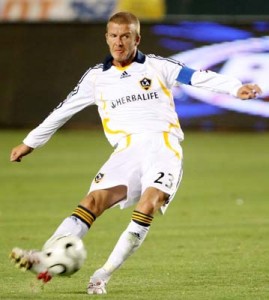
David Beckham has earned an ARP rating of 6, having played for Manchester United, Preston North End, Real Madrid, the Los Angeles Galaxy (+2) and AC Milan.
Green Card Caution (ARP rating = +1)
– Any athlete who has played professionally outside of North America will have an extra ARP assigned to their rating in addition to the standard penalty.
Players will not be penalized for beginning their careers outside of North America. However, should they play more than 10 games in North America and then move to a professional league outside of the United States or Canada, the rule applies.
If labour issues halt a North American league’s regular season, this rule is suspended for the duration of the work stoppage.
NOTE: For soccer players, replace “North America” with “Europe”.
What’s that? Stephon Marbury is the starting point guard with the Shanxi Zhongyu Brave Dragons? Yeah, you better believe that he’s crazy.
Neon Deion Condition (ARP rating = x1.5) = Applies to any “two-sport” athlete who participates in more than one professional sports league in a single calendar year.
Bo Jackson could’ve been a fantastic baseball player. Or a fantastic football player. He chose both. The decision cost the Los Angeles Raiders and Kansas City Royals an all-star because he required hip replacement surgery at the ripe old age of 28, when he should have been in his athletic prime.
The Royals (or Raiders) should’ve turned him away the second they realized he was going to be playing in another league.
The next time you hear that your favourite team is pursuing a veteran free agent or trading for a seasoned all-star, consider the Arenas Rule and do some math with the various stipulations. If you come up with an ARP of 3 or higher, you should be concerned.
Toronto has two strikes against it for most professional athletes
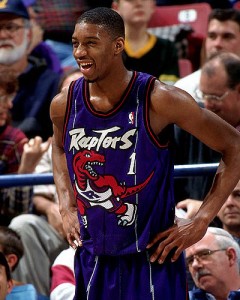
Former Toronto Raptor Tracy McGrady recently enlightened Torontonians as to why he left the Raptors.
This summer could be particularly heart-breaking for fans of the Toronto Raptors as they face the prospect of forward Chris Bosh, arguably the best player the team has ever seen, leaving the city as a free agent.
Toronto Blue Jays fans can sympathize with their basketball neighbours – this summer they lost ace Roy Halladay in a lopsided trade with the Philadelphia Phillies and Seattle Mariners.
It’s a familiar story for Torontonians. One of their teams will draft a player who becomes a star, but the franchise player eventually begins to grumble and complain about greener pastures, eventually demanding a trade or letting their contract expire and moving on via free agency.
Fortunately, NBA All-Star Tracy McGrady, a former Raptor, was in town and shed some light on the topic during a shoot-around with his teammates on the New York Knicks.
“Some guys do it for different reasons,” McGrady said. “[Bosh has] been here for quite some time now, and he's personally been successful. The team really hasn't done that much.”
And that’s the problem – teams in Toronto struggle against American competition. There are two main reasons for this:
1. The taxes in Canada limit team’s options when it comes to free agency.
Any professional athlete in a major sport (basketball, baseball, hockey) is going to earn in the high six figures.
In the United States, that would put them in the highest tax bracket, where they’d have to pay about 4.3% of their annual income to the federal government.
Employees in Canada who earn more than $126,264 pay 29% of their annual income to the federal government.
That is a jarring disparity. An athlete who earns $10 million per year on the Blue Jays or the Raptors would have to pay $2.9 million to the taxman. In the United States that same athlete would have to pay $430,000.
It’s tough to compete with other teams for prized free agents when they player will be losing 29% on the dollar just for signing on the dotted line.
2. Teams in Toronto offer less media exposure, making it a less attractive option for players.
Toronto is the biggest media centre in Canada, and actually stacks up pretty well against other North American cities in terms of population (fifth largest city, eighth largest metropolitan area).
However, sports teams based in Toronto get the short end of the stick when it comes to being televised on American networks.
Without a high profile in the United States an athlete can’t capitalize on their secondary source of income – endorsements and sponsorships. For example, Chris Bosh was drafted in 2003, the same year as LeBron James, Dwyane Wade and Carmelo Anthony. However, Bosh doesn’t even rank in the top 15 for jersey sales, and neither does Toronto for team sales. By comparison, all of Bosh’s draftmates rate highly on the list, even though they play for teams in smaller markets.
It all boils down to money. Professional athletes lose significant amounts of income from both of their main revenue sources, which makes Toronto a tough sell.
Some of you may be wondering why I haven’t mentioned hockey, a sport that has six teams in Canada? Simple, really.
Most hockey players are Canadian, and so they’re used to heavy taxation. The second largest group of players in the National Hockey League are European, who are also used to high taxes.
Beyond Sidney Crosby and Alexander Ovechkin, most players don’t expect, hockey players aren’t expecting much revenue from endorsements and sponsorship.
Also, the fact that there are six Canadian teams mitigates the lack of coverage in the United States - ESPN can ignore the Raptors and Blue Jays because they’re the only Canadian teams in the league, but when there’s at least one Canadian team playing every night and every franchise prominently features athletes from Canada, they’ve got no choice but to acknowledge non-American teams.
As an aside, all this adds to the fact that the Buffalo Bills, or any other team NFL team, would not work in Toronto.
All this is to say that in leagues where there is only one Canadian team (NBA, MLB and the MLS) there is a nearly unique set of challenges that face franchises based in Toronto. When the Raptors, Blue Jays and TFC struggle in the standings and begin to lose marquee players, it’s probably because they’re not grappling with the reality of the market.
Sure, a team can draft a young prospect, but it’s tremendously difficult to put together a team that can contend for the championship when so many players see Toronto as an undesirable city to play in.
My weekend in junior hockey, Mar. 5 – 7
There’s only one more week of the Canadian Hockey League’s regular season, and it’s do-or-die time for several teams.
The Quebec Major Junior Hockey League has 14 of its 16 playoff berths decided, with the Val-d’Or Foreurs, Lewiston Maineiacs and Baie-Comeau Drakkar vying for the two final spots.
With just 45 points and three games left in their season, the Drakkar seem like the obvious candidate to be on the outside looking in. They could still make it but they will need to reel off some wins.
The Ontario Hockey League’s Western Conference is all settled, but in the East there are still three post-season spots available.
The Belleville Bulls are already mathematically eliminated, with one of the Peterborough Petes, Niagara IceDogs, Sudbury Wolves and Oshawa Generals joining them within the next seven days.
The Western Hockey League has the clearest picture of who is in and who is out. The Western Conference has been sorted out for weeks, while the East has only one seed still available.
The Swift Current Broncos have the inside edge with 73 points, put the Prince Albert Raiders (67) and the Regina Pats (65) are within spitting distance. All three teams have played 69 games.
By the time I check in for my shift on Friday, I expect there will be even more teams eliminated from playoff contention. It’s been a good, tight race all season, with hotly contested matches in every CHL league.
Friday, Mar. 5th 2010
QMJHL – Wildcats nip Saint John in shootout
The Moncton Wildcats delayed celebrations in Saint John for at least one more game.
Kelsey Tessier and Nicolas Deschamps scored in the shootout as the Wildcats disappointed the Sea Dogs 4-3 in Quebec Major Junior Hockey League action Friday night. (See more...)
OHL – Cowick, Toffoli and Lindsay lead 67’s past Colts
The Ottawa 67's got a big win off of their Ontario Hockey League Eastern Conference rivals Friday night.
Corey Cowick, Tyler Toffoli and Cody Lindsay each had a goal and an assist as Ottawa knocked off the Barrie Colts 6-3. (See more...)
WHL – Weal scores twice as Pats hold off Hurricanes
Jordan Weal and the Regina Pats bested their cellar-mates Friday night.
Weal scored twice to help Regina double the Lethbridge Hurricanes 4-2 in Western Hockey League play. (See more...)
Saturday, Mar. 6th 2010
QMJHL – Piche, Voltigeurs roll to 7-0 win over Val-d’Or
The Drummondville Voltigeurs continue to have one of the stingiest defences in the Quebec Major Junior Hockey League.
Frederic Piche earned the first shutout of his QMJHL career as Drummondville blasted the Val-d'Or Foreurs 7-0 Saturday night. (See more...)
OHL – Kadri stars for Knights in win over Sting
The London Knights are gaining some momentum as the Ontario Hockey League's regular season winds down.
Toronto Maple Leaf prospect Nazem Kadri scored in the shootout as London dumped the Sarnia Sting 4-3 in OHL action Saturday night. (See more...)
WHL – Ross leads Portland past Tri-City
The Kelowna Rockets only needed Adam Brown and Tyson Barrie Saturday night.
Brown made 26 saves for the Rockets, earning his sixth shutout of the season, as Kelowna beat the Vancouver Giants 3-0 in Western Hockey League action. (See more...)
Sunday, Mar. 7th 2010
QMJHL – Seas Dogs clinch best record with win over Mooseheads
The Saint John Sea Dogs locked up home ice advantage for the Quebec Major Junior Hockey League playoffs on Sunday afternoon.
Mike Hoffman had a goal and two assists as Saint John beat the Halifax Mooseheads 5-2 in QMJHL action. (See more...)
OHL – Fowler stars for Spitfires in shutout of Greyhounds
Cam Fowler and Phillip Grubauer led the Windsor Spitfires as a familiar face returned to the line-up.
Fowler scored twice and Grubauer made 20 saves as the Windsor Spitfires defeated the Sault Ste. Marie Greyhounds 4-0 in Ontario Hockey League action Sunday afternoon. (See more...)
Trade deadline day is over-rated
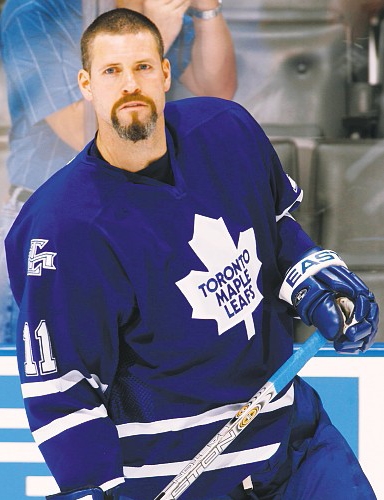 Although I’m still a young pup in this sports journalism game, most of my friends and family, as well as people following me on Twitter, have often ask me for my opinion on major events in sports.
Although I’m still a young pup in this sports journalism game, most of my friends and family, as well as people following me on Twitter, have often ask me for my opinion on major events in sports.
As you can imagine, I took lots of questions about the National Hockey League’s trade deadline. People wanted to know about what deals I thought would happen and how I felt about the moves teams made.
You know what? I didn’t think much of it at all. It’s a boring, media-generated event that is over-hyped.
This wasn’t always the case. I remember being an undergraduate at the University of Toronto and stopping people on the street to ask if they’d heard what the latest trade was and congregating with friends between classes to talk about the latest move.
Back then, big names were thrown around. I remember the palpable sense of excitement when the Toronto Maple Leafs landed Owen Nolan in 2003. I also remember the sense of regret and foreboding when the Leafs missed out on Rob Blake in 2001.
The difference between then and now is that the post-lockout collective bargaining agreement has instituted a salary cap (as well as a minimum) for all teams. Adding a big ticket player destroys any franchise’s budget. This cap makes crazy, last minute moves virtually impossible.
Yes, there have been some major moves made close to or on the deadline like Marian Hossa joining the Pittsburgh Penguins in Feb. 2008 or this year’s trade of Ilya Kovalchuk from the Atlanta Thrashers to the New Jersey Devils. But these deals were motivated by teams trying to dump expiring contracts before the free agents walked away for nothing. They are very temporary, and took months to negotiate.
Instead of the free-wheeling desperation deals of yore, trade deadline day consists of a gaggle of analysts trying to fill air time between commercials for hours on end.
I watched TSN’s coverage, which spent several segments introducing the many commentators they’d employed for the day. After nearly three hours of coverage they began to break some news, like the thrilling trades of Derek Morris for a fourth round pick in 2011 or Martin Skoula (being traded by a team he never played with) for a fifth round pick. Yawn.
If you really want to see exciting personnel moves in the NHL, wait for free agency to open up in the summer. That’s where teams are made in this day and age, not at the trade deadline. No, now the last day of the deal-making season is the home of third line centres and depth defencemen.
Where does Sunday’s Olympic final place in Canadian hockey history?
Three days after Sidney Crosby scored in overtime to lift the Canadian national team to a 3-2 triumph over Team USA in the Olympic hockey final, the Canadian people are still deliriously happy. It’s the biggest international hockey win since the 2002 Salt Lake City games.
The most recent win is always the sweetest, but how does Sunday’s game rate in Canadian hockey history? I’m sorry to say that to me, it the fifth biggest... let’s break it down.
5. Sidney Crosby and Team Canada down Team USA 3-2 in overtime for Olympic gold
It capped a thrilling two weeks where Canada, at long last, won a gold medal on home soil, and then rolled to 13 more first place finishes for the Winter Olympics record. Canada also gained a measure of revenge against the United States who had embarrassed them earlier in the tournament, beating them 5-3.
Canada’s win was big for several reasons.
First and foremost, it was on home soil, with nearly 80% of Canada’s population watching in the arena or on television. What other event could captivate four out of every five people?
It also served as the perfect cap to two weeks of patriotic build up. Like a dam straining against a swollen river, Crosby’s goal unleashed the flood gates.
Crosby himself had virtually disappeared for the last three games, being held off the point sheet even in routs like Canada’s 7-2 man-thrashing of Russia. Having him rise to the occasion in extra time made it all the more surprising.
4. Team Canada’s 3-2 win over the United States to win the Olympic gold medal in women’s hockey
The only thing better than winning at home is winning on the road and disappointing your opponents’ fans.
Cassie Campbell, Hayley Wickenheiser, Cheri Piper, Kim St. Pierre and the rest of the women on Team Canada did just that as they dropped their one – and only – hockey rivals, Team USA.
There are two factors that make this victory particularly sweet. The first is that for once, Canada was the underdog in international hockey. That’s right, the Americans had won their previous eight meetings. That’s a heck of a big monkey for Team Canada to carry on their backs and it made this ninth meeting on the biggest of all stages especially intense.
The other is that the referee (an American) called a series of questionable penalties, all against the Canadians, including five straight in the second period and a total of 13. The United States were only assessed four minors, meaning that the Canadian squad had to play on its heels the entire time.
Holding off a late surge, the Canadian women held off their arch-rivals for the biggest win in women’s hockey history.
3. Montreal Canadiens and Red Army battle to 3-3 tie on Dec. 31st 1975
Super-Series ’76 grew out of the popularity and success of the 1972 and 1974 Summit Series. Instead of playing all-star teams from the National Hockey League and the World Hockey Association, the Super-Series pitted the Soviet Wings and the Red Army (two of the top teams in the Soviet Union’s hockey league) against eight NHL teams.
The Canadiens were one of the best teams in the NHL at the time and went on to win the Stanley Cup that season. Many considered it to be a World Championship of professional hockey. It ended up being was a showcase for the considerable talents of Soviet goaltender Vladislav Tretiak who faced 35 shots while his team only mustered 13 against future Liberal MP Ken Dryden.
Unlike the other games on this list, Canada didn’t win. However, as argued over on HockeyAdventure.com, it was the most entertaining game ever.
As a whole, the Super-Series underscored the fact that Soviet-style hockey could work against North American teams, moving the NHL towards the fire-wagon brand of hockey popular in the 1980s.
2. Canadian men top Team USA 5-2 in Olympic gold medal game
The most memorable and important hockey game in my lifetime, this game is significant for several reasons.
First of all, it allowed Team Canada and the nation as a whole a level of catharsis after being upset by the Czech Republic in the 1998 Olympics in Nagano as well as avenging themselves on Team USA after a devastating loss to the Americans at the inaugural World Cup of Hockey.
Both losses had wounded the national psyche and called into questions the direction of Hockey Canada.
Further, Canada hadn’t won a gold medal in the Olympics for fifty years, not since the 1952 games in Oslo, Norway. It was an opportunity to regain dominance in a sport that many Canadians consider their rightful property.
It also featured the best hockey play I’ve ever seen.
With the United States leading 1-0, Chris Pronger carried the puck past the blue-line where he suddenly stopped, shaking off the American covering him. He wired a pass to captain Mario Lemieux who raised his stick for a one-timer. As a smile flashed across his face, the cornerstone of the Pittsburgh Penguins let the puck slip between his legs to a streaking Paul Kariya who snapped a shot past a startled Mike Richter.
Pronger’s pass was good. Kariya’s speed and skill were great. But nothing – nothing – will ever top the incredible hockey sense and awareness that Lemieux displayed on that play. I could watch that play all day, every day. It’s poetry in motion.
1. Canada wins on Paul Henderson’s goal in the final minute of the eighth game of the 1972 Summit Series
You knew this had to be number one. The gran’ daddy of them all, the 1972 Summit Series irrevocably changed the international game of hockey, undoubtedly for the better.
The context of the series itself was incredible. Canada had withdrawn from almost all international competition, even going so far as to cancel the 1970 World Junior Championship in Winnipeg.
As a result, only a handful of North Americans had ever seen the Soviets play hockey. The game developed in a vacuum behind the Iron Curtain, creating a more finessed style of play that relied heavily on teamwork and passing plays as well as conditioning and stamina.
Canada’s brand of hockey was a more physical, individual game including using their bodies to block shots. Team Canada’s stickwork was fancier, using tape-to-tape passes that didn’t touch the ice and flipping the puck in over the defence.
The styles clash was epic, and changed how the game is played as both sides of the Cold War began using each other’s tactics and strategies.
Further, sports were becoming increasingly political. Just that summer the Israeli team had been massacred at the Munich Olympics and most African nations had boycotted the summer games entirely to protest Rhodesia’s apartheid state.
Also, unlike the other matches on this list, the Summit Series was played over the course of four weeks with tension mounting after each game. By the time the eighth and final game was played in Moscow, it seemed like the Cold War was hanging in the balance.
That last game is a classic. Whether it’s Peter Mahovilich jumping over the boards to rescue Alan Eagleson from Red Army officers or J.P. Parise threatening to slash one of the referees, the tension is palpable. With Henderson’s wonderful, desperate goal all of that pent up emotion was unleashed in a moment that still sends chills down Canadian spines.
Nothing will ever be able to top that moment for Canadians.
Richard Martel of the Chicoutimi Sagueneens now QMJHL’s winningest head coach
In addition to writing junior hockey round-ups and watching the Olympics, I spent much of my weekend putting together a feature story for the Canadian Press on Richard Martel's record-setting 570th Quebec Major Junior Hockey League win.
No one is more surprised to be the Quebec Major Hockey League’s winningest head coach than Richard Martel.
Martel achieved the milestone Sunday night when his Chicoutimi Sagueneens beat the Baie-Comeau Drakkar 3-1 for his 570th career victory. With that, he surpassed QMJHL Hall of Famer Guy Chouinard for the all-time record.
“When I started in the QMJHL I just wanted to be involved in the hockey community,” said Martel. “I thought I’d have a job for a long time, but not for 20 years.
“I’m very proud to be a coach in the QMJHL . . . I feel privileged — very privileged.”
Since it was written for syndication, it's been picked up by several newspapers and websites including the Globe and Mail, the Winnipeg Free Press, the Guelph Mercury, the Halifax Metro and SportsEast.ca.
I was really pleased with this article and I hope you enjoy it too.
My weekend in junior hockey, Feb. 26-28
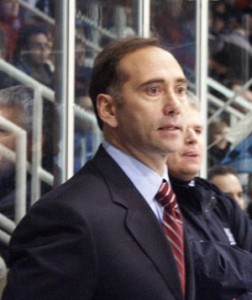
Richard Martel, head coach of the Chicoutimi Sagueneens won his 570th game on Sunday, a QMJHL record.
This weekend, when I wasn’t obsessing over the Olympics, I was all about the Quebec Major Junior Hockey League.
It was an incredible couple of days with Moncton’s Nicola Riopel setting a goaltending record Saturday night, only to be topped less than 24 hours later by Drummondville’s Jake Allen. On top of that, Sunday saw Richard Martel become the winningest coach in league history when his Chicoutimi Sagueneens dropped the Baie-Comeau Drakkar 3-1.
But first, let’s talk about goaltending.
As a gross generalization, each league within the Canadian Hockey League produces particularly strong types of players. The Western Hockey League’s rough and tumble style lends itself to defensively minded players who are always ready to drop their gloves. The Ontario Hockey League produces tight, disciplined players who focus on positioning and off-puck work. The QMJHL? It’s all about the goalies.
The league is a factory for superstar goaltenders – Felix Potvin played for the Chicoutimi Sagueneens and Roberto Luongo played for the Val-d’Or Foreurs and the Acadie-Bathurst Titan.
As good as those two are, they’re not even the best to come out of the QMJHL. Patrick Roy and Martin Brodeur, the two best goaltenders ever came from the league, setting the standard for all netminders worldwide.
So when Nicola Riopel of the Wildcats passes all those names on his way to the second-longest shutout streak in league history it’s kind of a big deal. Riopel’s record ended at 179 minutes 59 seconds Saturday night.
However, it was an even bigger deal when Jake Allen of the Voltigeurs passed Riopel the very next day. Allen lasted nearly ten minutes longer, going 188 minutes 47 seconds without giving up a goal.
Really, it’s incredible stuff, and shows that these two players will be around for a long time.
Of course, it was all over-shadowed by Martel’s accomplishment of winning 570 games as a coach. Martel’s never won the President’s Cup as a head coach, but he did win it as an assistant way back in 1990 with the Sagueneens who were backstopped by a young Potvin.
I had the pleasure of speaking with Martel this past weekend for a feature story, and I was impressed with his humility and dedication to the young men he teaches. I also spoke to league commissioner Gilles Croteau who went on at length about what an asset Martel is to the league and Canadian hockey in general.
What a great weekend for hockey in Quebec.
Friday, Feb. 26 2010
QMJHL – P.E.I. drops Chicoutimi 4-3 in shootout
The Chicoutimi Sagueneens earned a point for their coach Richard Martel, but not a coveted milestone.
Cody Linteau had the only goal in the shootout as the P.E.I. Rocket disappointed the Sagueneens 4-3 in Quebec Major Junior Hockey League action Friday night. (See more...)
OHL – Tanski, Hodgson help Battalion defeat Majors
Cody Hodgson's return to the Brampton Battalion could not have been more timely.
Scott Tanski and Hodgson combined for three goals and six points to spark the Battalion to a 4-0 victory over the Mississauga St. Michael's Majors on Friday night in the Ontario Hockey League. (See more...)
WHL – Bloodoff brothers both score as Kelowna beats Oil Kings
Three streaks came to an end in Edmonton Friday night.
Brothers Lucas and Evan Bloodoff scored as the Kelowna Rockets snapped a five-game losing streak with a 4-0 victory over the Oil Kings in Western Hockey League action. (See more...)
Saturday, Feb. 27 2010
QMJHL – Wildcats edge Halifax as Riopel makes QMJHL history
Nicola Riopel has made his mark in Quebec Major Junior Hockey League history.
Riopel made 21 saves as the Moncton Wildcats edged the Halifax Mooseheads 4-3 on Saturday. (See more...)
OHL – Erie stays in playoff hunt with win over Ottawa
The struggle for playoff spots continues in the Ontario Hockey League.
Anthony Luciani and Greg McKegg scored twice as the Erie Otters dropped the Ottawa 67's 7-1 Saturday night. (See more...)
WHL – Stanton scores twice as Warriors edge Bruins
The Moose Jaw Warriors have made the most of their time at home.
Defenceman Ryan Stanton scored twice as Moose Jaw hung on to beat the Chilliwack Bruins 3-2 in Western Hockey League action Saturday. (See more...)
Sunday, Feb. 28 2010
QMJHL – Martel wins 570th as Chicoutimi sinks Baie-Comeau
Sunday was a record-setting day in the Quebec Major Junior Hockey League.
Chicoutimi Sagueneens' head coach Richard Martel earned his 570th career victory, the most in QMJHL history, as Chicoutimi sank the Baie-Comeau Drakkar 3-1. (See more...)
OHL – Lopes scores two as Majors prevail over Oshawa
The Mississauga St. Michael's Majors are firing on all cylinders as the playoff window is closing on the Oshawa Generals.
Ryan Lopes scored a pair of goals and defencemen David Corrente and Blake Parlett had four-point games to power Mississauga to a 7-4 triumph over Oshawa in Ontario Hockey League action Sunday afternoon. (See more...)
Canada/USA has made me into a fan of women’s hockey
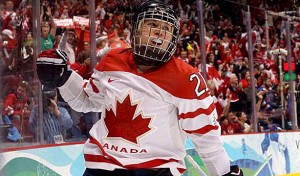 I am embarrassed to admit that last night was the first time I have ever watched a women’s hockey game from start to finish. A terrible sin, I know.
I am embarrassed to admit that last night was the first time I have ever watched a women’s hockey game from start to finish. A terrible sin, I know.
I had seen periods from games or seen bits and pieces, but for a host of reasons I’ve never been able to sit and watch a women’s game to completion. But I’m glad I finally did.
It was the perfect game to watch as Canada held on to an early 2-0 lead to down their arch-rivals from the United States and win their third consecutive Olympic gold medal.
There was a lot to like about the match-up. As the prohibitive favourites in any international tournament, the North American teams had often locked up at the highest levels of competition, whether at the Olympics or World Championships. As a result, the two teams are very familiar with each other’s tactics and strategies.
It quickly became apparent that women’s hockey has a style all its own thanks largely to the prohibition of body checking.
Personally, I’ve always thought this was a sexist rule that implied that women were too fragile to withstand physical play. It just made no sense – why could a woman not safely hit another woman? They would be physical equals, with no particular danger of injury.
However, the lack of big hits means that the scourge of entertaining hockey – the Trap – is impossible. The resulting game is fast and free-flowing with few stops in play. It’s refreshing compared to the National Hockey League where clogging the neutral zone has often been the fastest way to the playoffs.
The players on both teams were exceptional passers and play makers. Throughout the game there were creative tape-to-tape passes generating scoring chances. The Canadians in particular had a knack for finding each other on the ice.
When they had those openings, the Canadians were patient, waiting for defenders to over-commit themselves to a blocked shot. Canada often exploited their opponents’ mistake with a sharp pass for another quality chance. It was inspiring hockey.
Team Canada was also impressively dedicated to defence, dropping to their knees to block shots and passes, fending off a 5-on-3 power play for nearly a minute and a half at the start of the second period.
It was a lot of fun to watch, with both teams evenly matched.
That said, I don’t regret missing any of their other games. They were all lopsided blowouts that made me feel bad for the have-nots in women’s hockey. This is the sport’s greatest weakness – only a Canada-USA match-up showcases the very best of the game. Every other pairing is horribly one-sided.
When the next world championship rolls around, I’ll make sure to watch – as long as the game has Canada and the USA in it.
A side note: The fact that Team Canada had to apologize for their celebratory drinks and cigars on the ice is utter nonsense. The arena had emptied out and they were revelling in their success in what should have been a private moment. They should be allowed to let their hair down, guilt free.
I won’t go on any further, as too much ink has already been spilled over this story.
In Defence of Own the Podium
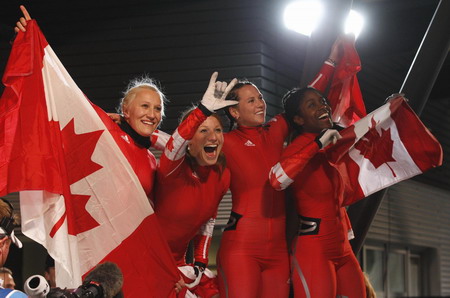 Wednesday was Canada’s best day for Olympic medals, with the teams of Kaillie Humphries/Heather Moyes and Helen Upperton/Shelley-Ann Brown winning gold and silver in a 1-2 punch in women’s two-person bobsleigh. The women's 5,000 metre speed skating relay team earned a silver medal. Adding to the medal haul was Clara Hughes, who earned her sixth career Olympic medal, a bronze in 5000m long track speed skating.
Wednesday was Canada’s best day for Olympic medals, with the teams of Kaillie Humphries/Heather Moyes and Helen Upperton/Shelley-Ann Brown winning gold and silver in a 1-2 punch in women’s two-person bobsleigh. The women's 5,000 metre speed skating relay team earned a silver medal. Adding to the medal haul was Clara Hughes, who earned her sixth career Olympic medal, a bronze in 5000m long track speed skating.
Although Team Canada’s 7-3 thrashing of the Russian Federation grabbed all the headlines, it was a banner day for Canada’s less glamorous Olympic sports that may have helped justify the Canadian Olympic Committee’s controversial Own the Podium program, just as it appears to be on its last legs.
Designed to give Canada the highest medal count at the 2010 Vancouver games, the Own the Podium program increased spending on winter Olympic sports by $21-million annually over the course of five years, with money coming from provincial and federal governments as well as private sponsors like Bell Canada. The goal was for Canada to earn a total of 35 podium finishes.
This plan has drawn criticism from all corners. Other countries (particularly the British media) have described it as an “un-Canadian” initiative. Apparently, it’s against the national character to be competitive in anything other than men’s hockey. A proposterous claim given that the Olympics, by definition, is about pushing the envelope and achieving new heights.
At the same time, some domestic media were unhappy that so much public funding - $118 million in total – was being spent on athletics when it could be applied to pressing issues like education, health care or the flagging economy.
As of this writing, Canada has stepped on to the podium 15 times, and might finish in the top three in men and women’s hockey, men and women’s curling and speed skating. Realistically, Canada will finish with around 20 medals, just shy of their 2006 Turin total of 24, and well short of Own the Podium’s stated goal of 35. On Monday, the COC announced that it was no longer aiming to top the medal tables at Vancouver.
In other words, CEO Roger Jackson and his staff have disappointed just about everybody, except the athletes.
Although the program has not met expectations, I think that in the long run it will make Canada into a more formidable sporting nation. At long last, Canadian athletes are getting the support they so richly deserve, allowing them to finally put their best foot forward in international competition.
Their performance at the Vancouver games will serve as an inspiration to Canada’s youth, spawning a new generation of world-class athletes. Yes, the money could have been spent on other projects, but giving Canadian children role models to look up to is certainly a worthy pursuit.
Further, this initiative is just catching Canada up to the rest of the world. In many cases, the athletes from other nations in the winter Olympics are members of the military.
For example, Tuffy LaTour, the coach of Canadian men’s bobsleigh team, is a retired army sergeant from the United States who competed with the American military’s sledding team.
Dan Humphries, the husband of Canadian gold medalist Kaillie Humphries, and a member of Canada’s four-man bobsleigh team, was originally a member of the British Army’s slidding team.
Heck, Finland won the Winter War against the Soviet Union by their superior biathlon skills.
Canada, with its significantly smaller population and military complex, needs a boost to its athletics programs, and Own the Podium is it.
Just as the Calgary Olympics created a home base for Canadian sports, the combination of the Vancouver games and Own the Podium will start a new golden age in the Canadian Olympic movement. It appears as though most of Own the Podium's sponsors, both public and private, will stop funding after the closing ceremonies this weekend, which would be a shame.
